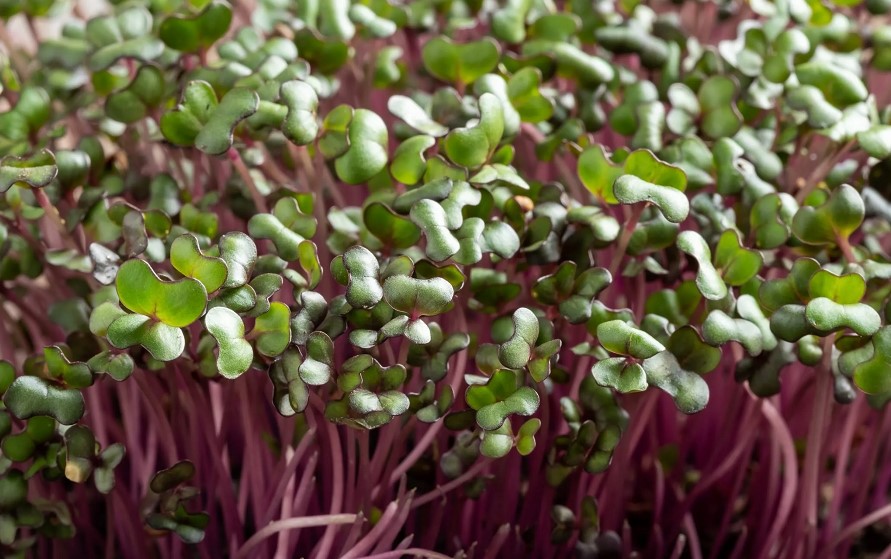Microgreens are known to be of significant health benefits. It is rich in a large number of vitamins and minerals while being quite easy to grow. To always have healthy greens at home, you can freeze them. Read more about red cabbage microgreens in this article.

Contents
What are red cabbage microgreens?
For starters, it makes sense to get acquainted with the features of red cabbage microgreens. Microgreens are small shoots of a young plant. It can be grown both in soil and hydroponically.
When the plants are between 2–3 inches tall, the greens can be cut. Microgreens have cotyledons that look like seed leaves. They contain all the nutrients from the seeds.
If the sprouts are to be consumed whole, then the microgreens are cut slightly above ground level.
Cabbage microgreens are small bushes that are grown from cabbage seeds. The leaves are edible and ready to eat within a few weeks of sowing. There are many varieties of cabbage on sale; however, red cabbage is in the greatest demand.

Why is red cabbage so popular?
This type of cabbage is also called purple and red acre. It contains a huge nutritional boost when compared with other species. It contains a lot of vitamin C, antioxidants, carotene, etc. As part of red cabbage, there are almost 5 times more antioxidants, we are talking about other types.
Red cabbage microgreens help prevent Alzheimer’s disease as well as cancer. Therefore, be sure to include cabbage microgreens in your diet every day. According to statistics, cabbage microgreens contain almost 40 times more vitamins and minerals when compared with other types.
Therefore, if you add red acre cabbage to various juices or smoothies, you can saturate the body with everything you need. Cabbage microgreens are a great option for fresh salads and other raw food recipes. Thanks to the high concentration of vitamin C, you strengthen your immune system and be able to prevent colds.
Vitamin C is involved in the production of collagen. This positively affects the condition of bones, joints, and skin.

Health benefits of red cabbage microgreens
Most of the health benefits have been briefly described previously. Now we should consider the beneficial properties of cabbage microgreens in more detail.
Cancer prevention
Glucosinolates, which are part of red cabbage, are responsible for this. They have a sulfur base and begin to split when crushed. It should also be noted the presence of by-products, including nitriles and indoles. Together, they help prevent cancer.
Red cabbage microgreens contain isothiocyanates. They block harmful components that enter the body through smoke from smoking or air pollution. Today, these components are used to develop drugs that are directed against cancer.
Vegetables belonging to the cruciferous family can create protection against DNA damage. They also fight inflammation.
Improvement of the gastrointestinal tract
Red cabbage contains a chemical compound called vitamin U. Vitamin U is an excellent option to protect the stomach and intestines. The health benefits of this compound were first discovered in the middle of the last century.
Scientists have been able to prove that it helps in the treatment of ulcers, and enhances the protection of the gastric mucosa.
According to studies, it takes only a week and a half to treat an ulcer with red cabbage. If you consume red cabbage microgreens on a regular basis, you can prevent and cure various gastrointestinal diseases.

Preventing Alzheimer’s
As mentioned, red acre microgreens help prevent Alzheimer’s disease, which is a form of neurodegenerative disease. It, later, can develop into dementia. According to research, Alzheimer’s disease is caused by genetics and lifestyle, which damages the brain.
If you follow a diet, you can prevent this disease. In the tissues of the nervous system, with the development of Alzheimer’s disease, the number of amyloid plaques increases. If you use red cabbage microgreens, then the number of plaques is significantly reduced.
The presence of anthocyanins
Red cabbage microgreens are rich in anthocyanins. This is the component that gives the products a dark tint. They are also involved in preventing the growth of cancerous tumors. They also block oxidative stress in the body and contribute to the fight against carcinogens.
The oxidative process has been linked to Parkinson’s disease, asthma, high blood pressure, and diabetes. If you eat foods rich in anthocyanins, you can prevent the development of cancer cells and other diseases.
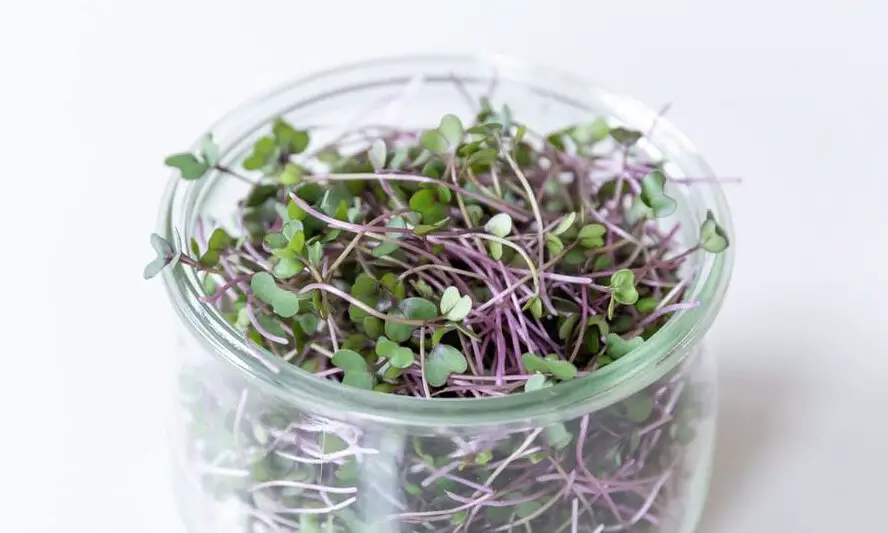
Weight support
According to research, red cabbage microgreens help prevent weight gain. In this case, cholesterol is maintained at the desired level.
At the same time, the number of antioxidants in the body increases, which helps to reduce triglycerides in the liver.
Today, in almost all countries, the problem of weight gain is only getting worse. This is caused by stress, poor diet, a sedentary lifestyle, etc. If you consume red acre cabbage microgreens every day, you can prevent obesity. At the same time, the condition of the heart will improve, and diabetes mellitus will be prevented.
Other useful properties
Red acre cabbage microgreens have several health benefits, including:
- prevention of the risk of cardiovascular disease;
- treatment of constipation;
- fight against inflammations;
- removal of toxins from the blood;
- normalization of nerve cells;
- tissue regeneration, so tissues and wounds heal faster;
- positive effect on vision;
- normalization of arterial pressure;
- prevention of osteoporosis;
- elimination of painful sensations;
- decrease in indicators of triglycerides.

Features of growing red cabbage microgreens
Growing cabbage microgreens at home is quite simple. Even beginners can handle the process. At the same time, you always have access to a nutritious and healthy product. More details about the growing process will be discussed below.
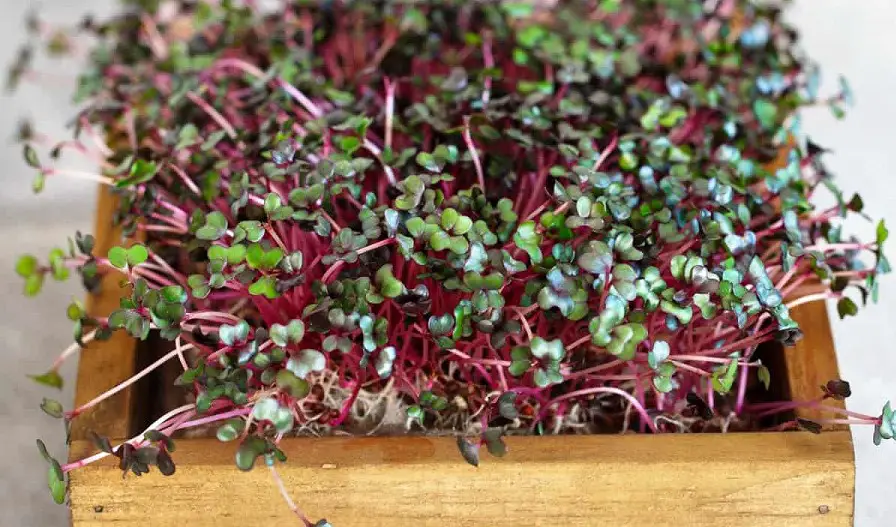
List of required materials
If you’re planning to grow cabbage microgreens, the first step is to prepare a list of certain materials.
Soil for the pot
Choose organic soil that is free of chemicals. If organic compost is available, it can be added to the soil to make it more nutritious. It is allowed to use other materials, including coconut coir or hemp mats.
Seed
There is a wide range of cabbage seeds for sale. The choice depends on which variety you plan to grow. It is better to make a purchase in a special grocery store. Give preference to untreated cabbage seeds. They will rise better. If the tray is 10 x 20 inches, then 1 ounce of seed will be required.
Grow tray with lid
You can buy ready-made containers that are supplemented with a lid. If this is not possible, you can take ordinary shallow containers. These can be pie dishes, aluminum baking containers, etc.
If you are using containers that have already been in use, then they need to be sterilized first. You also need to manually make a few holes that provide optimal drainage.
Water collector
It is recommended to fill it with clean water that is drinkable. It is possible that tap water will not be the best option. It might contain contaminants. Therefore, it is better to stop bottled or distilled water.
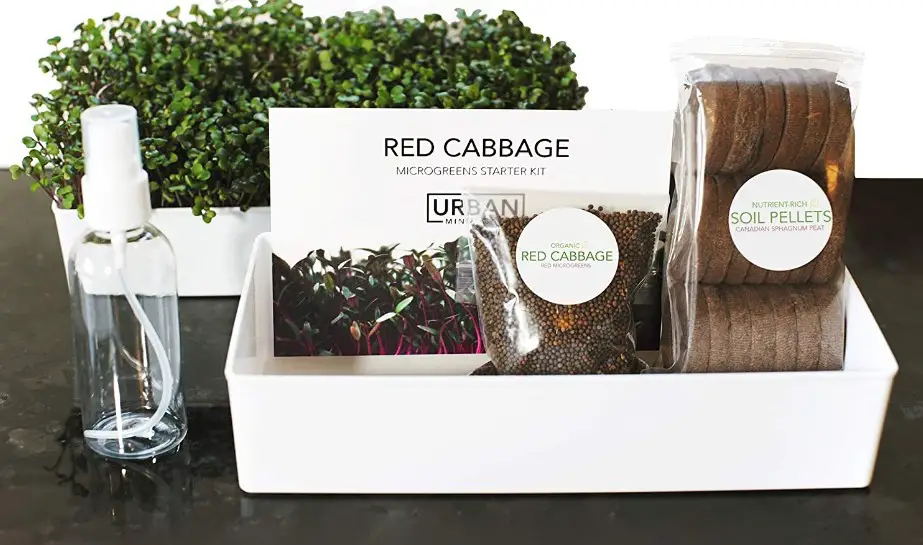
Further growing steps
Once all the materials are ready, you can proceed to the main stages of cultivation. More about them will be discussed below.
Soil preparation
Their soil needs to be cleaned of debris and stones. Prepared soil needs to fill the tray. After it must be carefully tamped. With the help of a hydraulic sprayer, you can moisten the soil well and evenly. However, be careful not to get too wet.
Sowing seeds
After, you need to evenly distribute the seeds on the surface of the soil. Next, they need to press the microgreens seeds into the soil a little with their hands. If you don’t want to get your hands dirty, you can use cardboard. After, if desired, you can cover the seed with a small amount of soil. However, this slightly extends the germination of seeds.
Fog watering
Once you have covered the seeds, water them with a spray bottle. It should not be overwatered so that the seeds do not rot inside the soil.
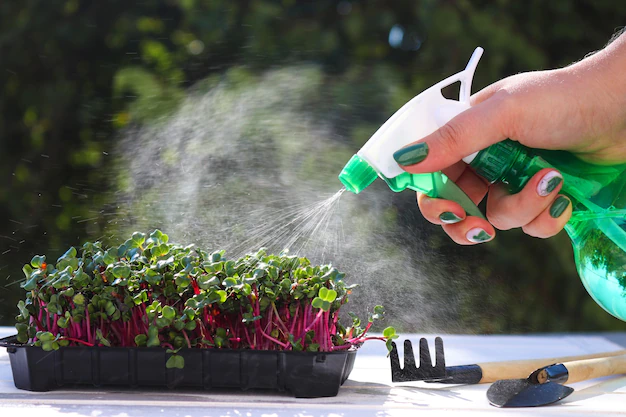
Cover replacement
After, the container must be covered with a lid. This protects the soil and seed from sunlight and excessive moisture. The tray is recommended to be installed in a dark place. The temperature should be room temperature. This will promote active seed growth.
You need to cover the containers for 3 days. After that, watering with a sprayer 1–2 times a day is required. However, you need to focus on the requirements of the soil. You have to change the cover each time. As soon as the cotyledons form after a few days, you have to remove the lid and place the tray on a windowsill that is well-lit by sunlight.
However, it is best to avoid direct sunlight. If the lid is not removed, the plants will be stressed and unable to grow healthy and strong.
Spraying and watering
A similar procedure must be performed periodically so that the soil remains moist. Microgreens should not be over-moistened, or they will develop root rot.
Avoid situations where leaves and shoots are covered with water. This may cause mold to form.
If the tray is equipped with drainage holes, an empty tray can be placed under it, which is filled with a small amount of water. This promotes proper absorption of moisture.
Harvesting
Harvesting is recommended after 5-14 days from the date of planting. You should grow cabbage microgreens to 1-3 inches. You can taste the fresh microgreens and harvest them based on your preferences. You need to cut the greens with sharp tools.
Harvesting mature cabbage is carried out immediately before use. Before use, you will need to rinse the product. Store microgreens in a paper towel, plastic bag, or container. The shelf life in the refrigerator is 1 week.
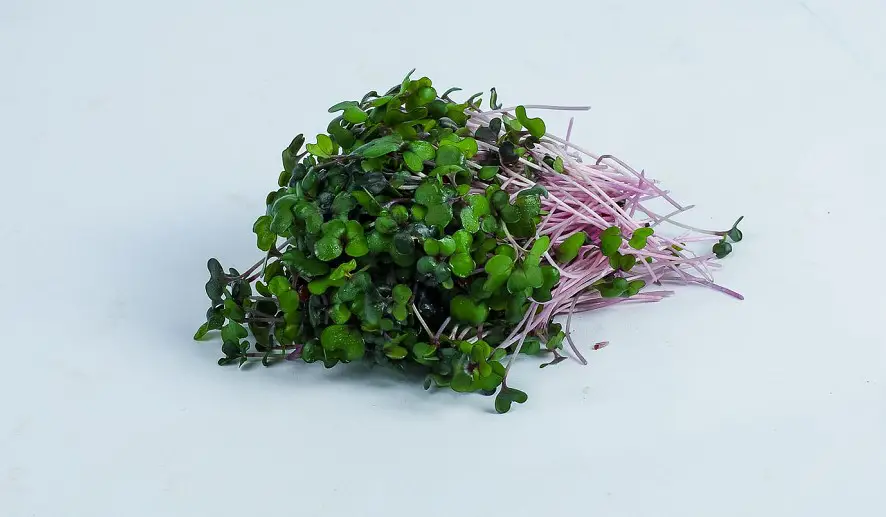
FAQ
When it comes to growing or benefiting from red cabbage microgreens, a lot of questions can arise.
What can I do with red cabbage microgreens?
You can make sandwiches or salads incorporating red cabbage microgreens. At the same time, it deliciously complements the cooked dish and saturates it with nutrients.
Are cabbage microgreens good for you?
Yes, cabbage microgreens are very beneficial for the body. The composition of greens contains a large number of useful trace elements, vitamins, and macronutrients. The highly concentrated vitamin C and vitamin K deserve special attention.
The mature red cabbage also contains a large amount of fiber, calcium, magnesium, sulfur, potassium, and iodine. It is important to note the beta-carotene.
What do cabbage microgreens taste like?
The cabbage microgreens can have different flavors. It can taste like broccoli, Brussels sprouts, and other plants that are part of the cruciferous family.
Results
As you can see, red cabbage microgreens have a lot of useful properties. Regular consumption of it helps to keep the body healthy. At the same time, growing microgreens is not difficult. The process is simple and very fast. Within a week after sowing the seeds, you can enjoy tasty and healthy herbs.

